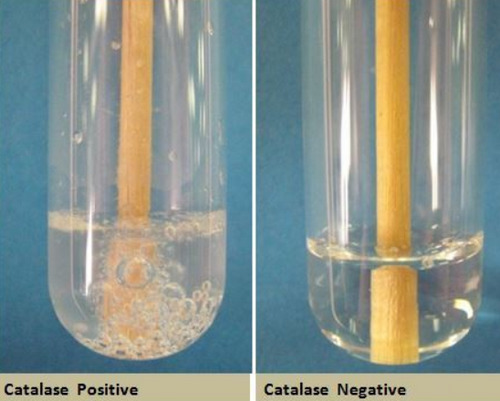Catalase Test
Last reviewed by Editorial Team on February 27th, 2019.
A catalase test is one of the laboratory procedures used to identify a particular strain of bacteria.
What is a Catalase?
It is an enzyme produced by organisms that thrive in an oxygenated environment. Its purpose is to neutralize toxic forms of oxygen metabolites.
It plays a very important role in the breakdown of hydrogen peroxide; breathing the hydrogen peroxide into water and oxygen.
A strain of bacteria can be categorized as a catalase-positive or catalase-negative. Those test positive for catalase have strict aerobes and facultative anaerobes.
They respire using oxygen as their terminal electron acceptor. On the other hand, those test negative for catalase can be anaerobes but can be facultative anaerobes that capable of fermenting but are not respiring using oxygen as their terminal electron acceptor. (1, 2, 3, 4)

Image 1: Microorganisms on the glass slide; the one on the left tested negative while the one on the right tested positive for catalase test.
Picture Source: i2.wp.com

Picture 2: A catalase test is performed using Staphylococcus and Streptococcus as mediums.
Photo Source: microbiologyinfo.com
What is the purpose of the catalase test?
- It differentiates aerotolerant strain of Clostridium from Bacillus species.
- It distinguishes Gram-positive cocci.
- A semi-quantitate catalase test is helpful in the identification of
- Mycobacterium tuberculosis.
- It helps identify Enterobacteriaceae.
- It differentiates Micrococcaceae from Streptococcaceae.
- It differentiates Aerococcus urinae (positive) from Aerococcus viridians (negative).
- It differentiates gram-negative Campylobacter from other Campylobacter species.
- It plays a vital role in differentiating aerobic and obligate anaerobic bacteria. (3, 4, 5, 6)
How does a catalase test work?
There are different ways and variations in performing a catalase test. They are the following:
- Slide/drop catalase test
- Tube method
- Semi-quantitative catalase test
- Heat stable catalase test
- Capillary tube
- Cover slip method
- Of all the above-mentioned methods the two most popular and commonly used are the slide/drop catalase method and tube method. They are easy to perform and require only a small amount of organisms. (4, 6, 7, 8)
How to perform a slide/drop catalase test?
- Place a small bacterial colony on a dry glass slide using a loop or a wooden stick.
- Put a drop of H2O2 3% on the slide and mix.
- If you see bubbling after a few seconds, then it indicates a rapid evolution of oxygen. This means that the catalase test is positive. If there is no bubbling or only a few scattered bubbles are formed, then the test is negative. (1, 5, 7, 8)

Photo 3: A catalase test using the test tube method.
Image Source: i1.wp.com
How is a tube catalase test performed?
- Put at least five drops of 3% H2O2 in a test tube.
- Place the colony of microorganism in the test tube using a wooden applicator stick.
- Position the test tube against a dark background and carefully observe for the formation of bubbles at the wooden applicator stick’s end.
- If bubbles are formed, then the test is positive. If no bubbles are formed, then the result is negative. (6, 9, 10)

Image 4: A catalase test using a tube slant method.
Picture Source: www.researchgate.net
Tube (Slant) Method
- An ml of hydrogen peroxide 3% concentrate should be added to microbial culture on the nutrient agar slant.
- Check for the reaction of the microorganism to hydrogen peroxide.
- Place the test tube against the dark background and observe if bubbles are formed which indicates a catalase-positive result. (2, 5, 8)
What are examples of catalase positive microorganisms?
- Micrococci
- Staphylococci
- Listeria
- Burkholderia cepacia
- Corynebacterium diphtheria
- Enterobacteriaceae family
- Pseudomonas
- Nocardia
- Aspergillus
- Mycobacterium tuberculosis
- Rhodococcus equi
- Cryptococcus (1, 2, 9)
What are examples of catalase negative microorganisms?
- Streptococcus
- Enterococcus spp
What to keep in mind when performing a catalase test?
- Using a metal loop or needle is a big no when performing a catalase test as it will result to degradation of the metal. It will also lead to a false positive result.
- The strength of hydrogen peroxide to be used in the test depends on the type of culture. For a routine culture, 3% hydrogen peroxide is used. For detection of catalase in anaerobes, 15% of hydrogen peroxide is used.
- Make sure you interpret the result accurately. A few bubbles do not mean that the result is positive because some bacteria have enzymes other than catalase that is reactive to hydrogen peroxide.
- The culture to be tested should be at least 18 hours old.
- Hydrogen peroxide is an unstable compound. Therefore, when performing a catalase test, make sure you are going to use a fresh hydrogen peroxide.
- If you are going to use a platinum inoculating loop, always add first the organism that is being tested. Adding the hydrogen peroxide first could lead to a false positive result.
- If you are going to use colonies from the blood agar plate make sure you do not scrape up the blood agar because blood cells are catalase positive. If the microorganisms being tested are contaminated with agar, it will lead to a false-positive result.
- Always observe a strict aseptic procedure. This type of test should be performed only under a biosafety hood. If you are not careful, you could be at a high risk for self-contamination. (3, 5, 8, 9, 10)
References:
- https://en.wikipedia.org/wiki/Catalase
- https://microbeonline.com/catalase-test-principle-uses-procedure-results/
- http://www.asmscience.org/content/education/protocol/protocol.3226
- https://microbiologyinfo.com/catalase-test-principle-uses-procedure-result-interpretation-with-precautions/
- https://www.ncbi.nlm.nih.gov/pmc/articles/PMC380547/
- https://aem.asm.org/content/24/1/58
- https://academic.oup.com/ajcp/article-abstract/69/1/36/1771206?redirectedFrom=PDF
- http://www.vumicro.com/vumie/help/VUMICRO/Catalase_Test.htm
- https://laboratoryinfo.com/catalase-test/
- https://microbenotes.com/catalase-test-principle-procedure-and-result-interpretation/
